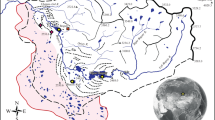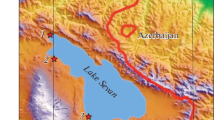Abstract
The following stages in the formation of sediments in Lake Baikal have been distinguished. In the Middle Miocene lacustrine deposits accumulated in the southern depression. In Early and Middle Pliocene, as well as in Early-Middle Pleistocene the bottom of the southern and middle Baikal depressions was occupied by large lakes, but the northern basin was mainly dry with a system of small lakes, streams and rivers. This accounts for the great facies variety and the genetic heterogeneity of sediments in the northern depression. At the end of Middle and in the Late Pleistocene an abrupt warping of the depression took place, and a shore-line similar to the present one was formed. Sands in the upper part of the sediments are considered to be the product of intensive erosion which probably occurred in the pluvial epoch in the Late Pleistocene period.
Similar content being viewed by others
References
Adamenko, R. S., 1975. Late Pliocene mammals in new discoveries of the Upper Lena. Biol. Comiss. on the study of the Quaternary period. Moscow, Nauka, N 43: 136–145 (in Russian).
Belova, V. A., 1973. Natural conditions in formation of the Baikal rift zone basins in the Cenozoic period. In: Grichuk, V. P. (ed.). Pleistocene and Pliocene Palynology. Proceedings of the III Intern. Palynological Conf. pp. 184–187. Moscow, Nauka (in Russian with English summary).
Belova, V. A., 1975. The history of development of basin vegetation of the Baikal rift zone. Moscow, Nauka (English summary).
Belova, V. A, & Endrikhinsky, A. S., 1980. Palynological evidence for the scratigraphy of the Neogene deposits of the Baikal rift zone. In: Paleopalynology of Siberia. Moscow, Nauka, 84–92.
Florensov, N. A., Belova, V. A., Goldyrev, G. S., Lut, B. F., Mats, V. D. & Popova, S. M., 1978. Some stages of Baikal Lake development in the Late Cenozoic era. Polskie archiwum Hydrobiologii. 25: 135–145.
Goldyrev, G. S., Belova, V. A., Vykhristyk, L. A., Lazo, F. J. & Fedorova, V. A., 1975. New data on the composition and age of the upper part of sedimentary rock mass in the Baikal depression. In: Florensov, N. A. & Logatchev, N. A. (eds.). Rifting Problems, pp. 40–41. Irkutsk, Publisher of Irkutsk (in English and Russian).
Lut, B. F., 1964. Geomorphology of the Baikal bottom. In: Florensov, N. A. (ed.). Geomorphology of the Baikal Bottom and Its Coasts, pp. 5–123. Moscow, Nauka.
Mats, V. D. & Pokatilov, A. G., 1976. The stratigraphy of the Quaternary sediments within the coastal zone of the Baikal. Izv. Acad. Nauk. SSSR. Set. Geol. 3: 133–139 (English summary).
Volkova, B. C. & Belova, V. A., 1981. Basic climatic boundaries of Siberia in Late Cenozoic. Proceedings of All-Union Conf. on Quaternary period. Ufa, Bashkiria.
Author information
Authors and Affiliations
Rights and permissions
About this article
Cite this article
Belova, V.A., Lut, B.F., Loginova, L.P. et al. Sediment formation in Lake Baikal. Hydrobiologia 103, 281–285 (1983). https://doi.org/10.1007/BF00028467
Issue Date:
DOI: https://doi.org/10.1007/BF00028467




